12 Best Lead Generation Management Software Picks for 2025
Tired of guessing? Discover the top 12 lead generation management software tools of 2025. In-depth analysis to help you capture and convert more leads.

You've poured heart and soul into creating something valuable—a product, a service, a killer piece of content. But the leads? They're either trickling in, unqualified, or falling through the cracks somewhere between a form submission and a sales call. It's a frustrating, all-too-common cycle that makes growth feel like a constant uphill battle. I've been there. The problem often isn't your offer; it's the chaotic, manual process holding you back. You need a system, a single source of truth to capture, organize, and nurture every single opportunity. This isn't just about getting more leads; it's about managing them intelligently so your sales team can focus on what they do best: closing deals.
Choosing the right lead generation management software is the first critical step to building a predictable revenue engine. But with a market saturated with options, from all-in-one CRMs to specialized prospecting tools, identifying the best fit for your specific team size, budget, and growth stage can be overwhelming. Before selecting a tool, it helps to have a solid strategy in place; this guide to lead generation campaigns in digital marketing provides a strong foundation for those fundamentals.
This comprehensive list cuts through the noise. We'll dive deep into the top platforms, analyzing not just their features, but their practical applications, honest limitations, and ideal use cases. You'll find detailed breakdowns of HubSpot, Salesforce, Pipedrive, and many others, complete with screenshots and direct links to help you make an informed decision. The goal is simple: to equip you with the insights needed to select a system that transforms your lead management from a source of stress into a streamlined, powerful engine for your business's growth.
1. HubSpot (Marketing Hub + CRM)
HubSpot is often the default starting point for businesses seeking a comprehensive lead generation management software solution, and for good reason. It provides an all-in-one platform where lead capture, nurturing, and CRM are tightly integrated, eliminating the data silos that often plague marketing and sales teams. Instead of juggling disparate tools for forms, email campaigns, and contact management, HubSpot centralizes these functions into a single, unified interface.
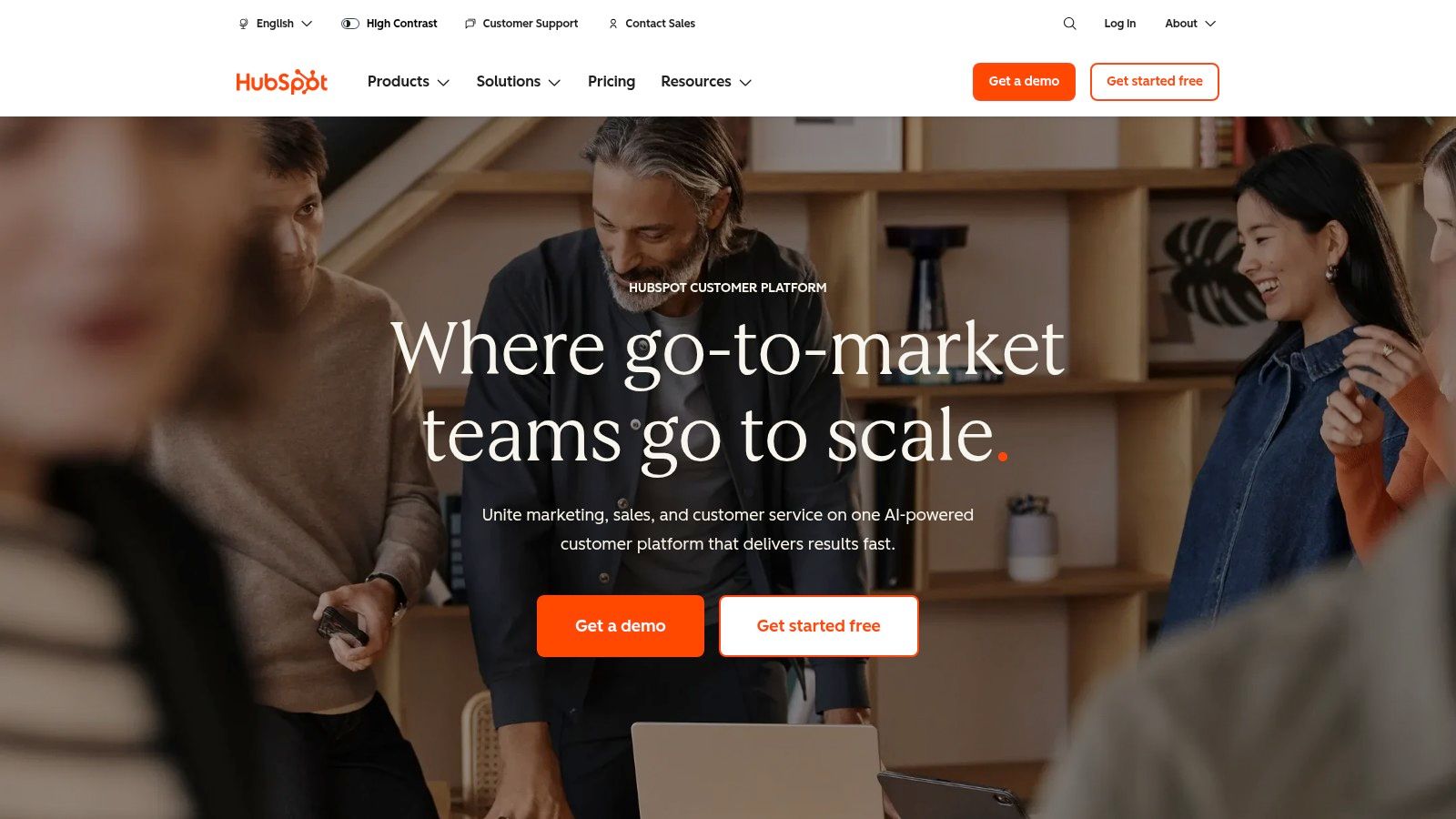
The platform truly shines with its powerful automation capabilities. You can set up workflows that automatically score leads based on their behavior, assign them to the right sales representative, and trigger personalized email nurture sequences. For instance, a lead who downloads a "Beginner's Guide" ebook can be automatically tagged and entered into a follow-up campaign with more advanced content, while a lead visiting the pricing page multiple times gets a higher score and an immediate sales alert. It's about letting the system handle the repetitive work so you can focus on strategy.
Key Strengths & Considerations
The free CRM and marketing tools offer immense value, providing a risk-free entry point for startups and small businesses. The upgrade path is seamless, allowing you to add more advanced features as your organization grows. However, this scalability comes at a price; costs for the Professional and Enterprise tiers can escalate quickly with additional contacts and paid user seats, which can be a significant drawback for teams on a tight budget. The platform’s depth, while a strength, can also introduce a steep learning curve for those new to marketing automation. To get a better sense of how it stacks up against other options, you can explore more insights on lead management software.
- Website: https://www.hubspot.com
2. Salesforce Sales Cloud (with lead management)
Salesforce Sales Cloud is the heavyweight champion in the CRM world, and its capabilities as a lead generation management software are deeply embedded within its enterprise-grade architecture. It’s designed for organizations that require a highly customizable and scalable platform to manage complex sales processes, from initial lead capture to final conversion. The platform centralizes lead data, providing a single source of truth that sales and marketing teams can rely on to track every interaction.
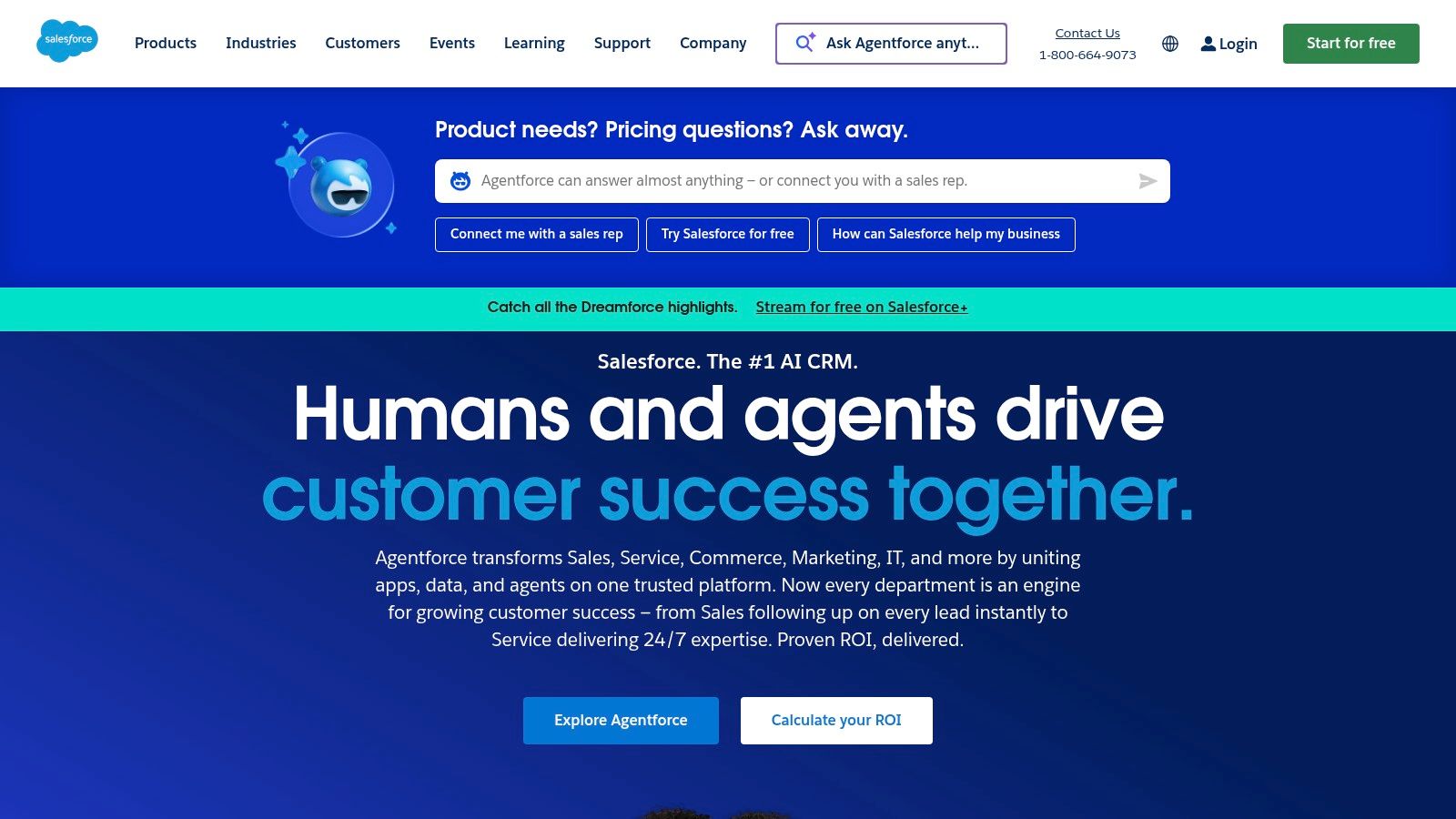
Its core strength lies in its powerful lead assignment and routing rules. You can create sophisticated, automated workflows that distribute leads based on criteria like geography, company size, or product interest, ensuring the right opportunities land with the right team members instantly. For example, a web form submission from a Fortune 500 company in France can be automatically routed to your enterprise sales team in Europe. For advanced marketing automation, it integrates seamlessly with its own tools, like Account Engagement (formerly Pardot), or you can tap into the vast AppExchange marketplace to connect virtually any third-party tool, building a bespoke lead management ecosystem.
Key Strengths & Considerations
The platform’s configurability is its greatest asset, allowing for industry-specific customizations that cater to unique business needs, from finance to healthcare. This ability to scale from a small business setup to a complex global enterprise deployment is unmatched. However, this flexibility introduces significant complexity; unlocking its full potential often requires a dedicated Salesforce administrator or implementation partner. While the base price may seem accessible, costs can quickly escalate with necessary add-ons for features like sales engagement or revenue intelligence, making it a substantial investment.
- Website: https://www.salesforce.com
3. Microsoft Dynamics 365 Sales
For organizations already embedded in the Microsoft ecosystem, Dynamics 365 Sales offers a powerful and familiar environment for lead generation management software. Its primary advantage lies in the native, seamless integration with tools like Outlook, Teams, and the wider Microsoft 365 suite. This creates a unified workspace where sellers can manage leads, engage prospects, and collaborate without constantly switching between applications, significantly reducing friction in the sales process.
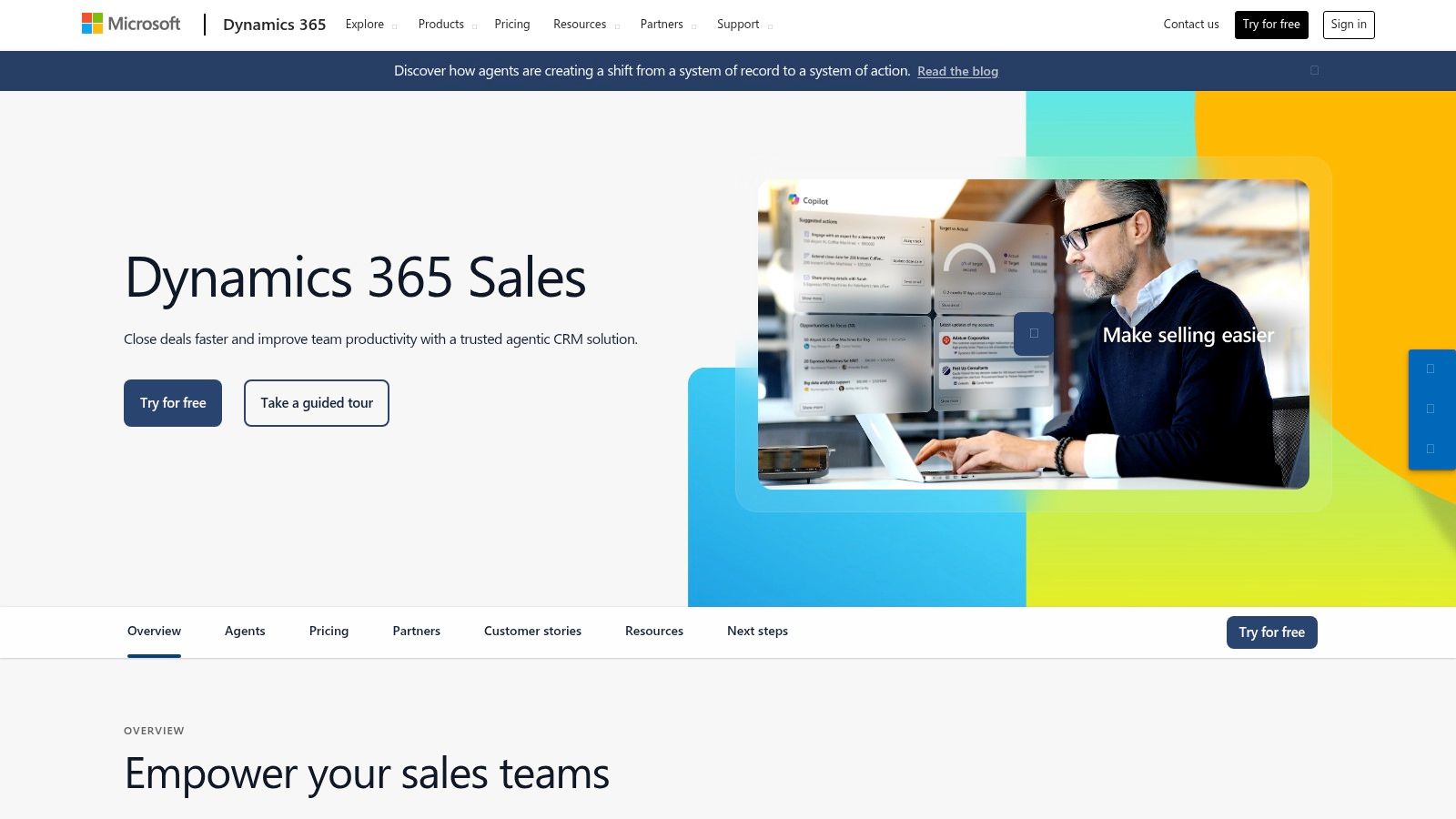
The platform leverages AI through its Copilot feature, offering real-time guidance, conversation intelligence, and automated task suggestions directly within the workflow. For instance, Copilot can summarize a lead's entire history from Outlook emails and past support tickets right before a call, or suggest the next best action based on recent interactions. The Relationship Sales bundle, which includes LinkedIn Sales Navigator, is a standout feature, providing deep insights and connection pathways that are invaluable for B2B sales teams focused on building strong prospect relationships.
Key Strengths & Considerations
The platform's robust security and administrative controls are a major draw for larger organizations with strict data governance requirements. The true value of Dynamics 365 is realized when a business is heavily invested in other Microsoft products. For companies using a different tech stack, the experience can feel less integrated, and many of the advanced AI and engagement features are locked behind the more expensive tiers. The reliance on the Microsoft suite means it’s not the most flexible choice for teams using Google Workspace or other ecosystems.
4. Pipedrive (CRM + LeadBooster add‑on)
Pipedrive is a sales-first CRM designed for speed and ease of adoption, making it a strong contender for SMBs who find more comprehensive platforms overly complex. Its core strength lies in its visual sales pipeline, but its power as a lead generation management software is fully realized with the LeadBooster add-on. This toolkit centralizes inbound lead capture by adding a chatbot, live chat, and customizable web forms directly to your website, feeding new prospects straight into your deal pipeline.
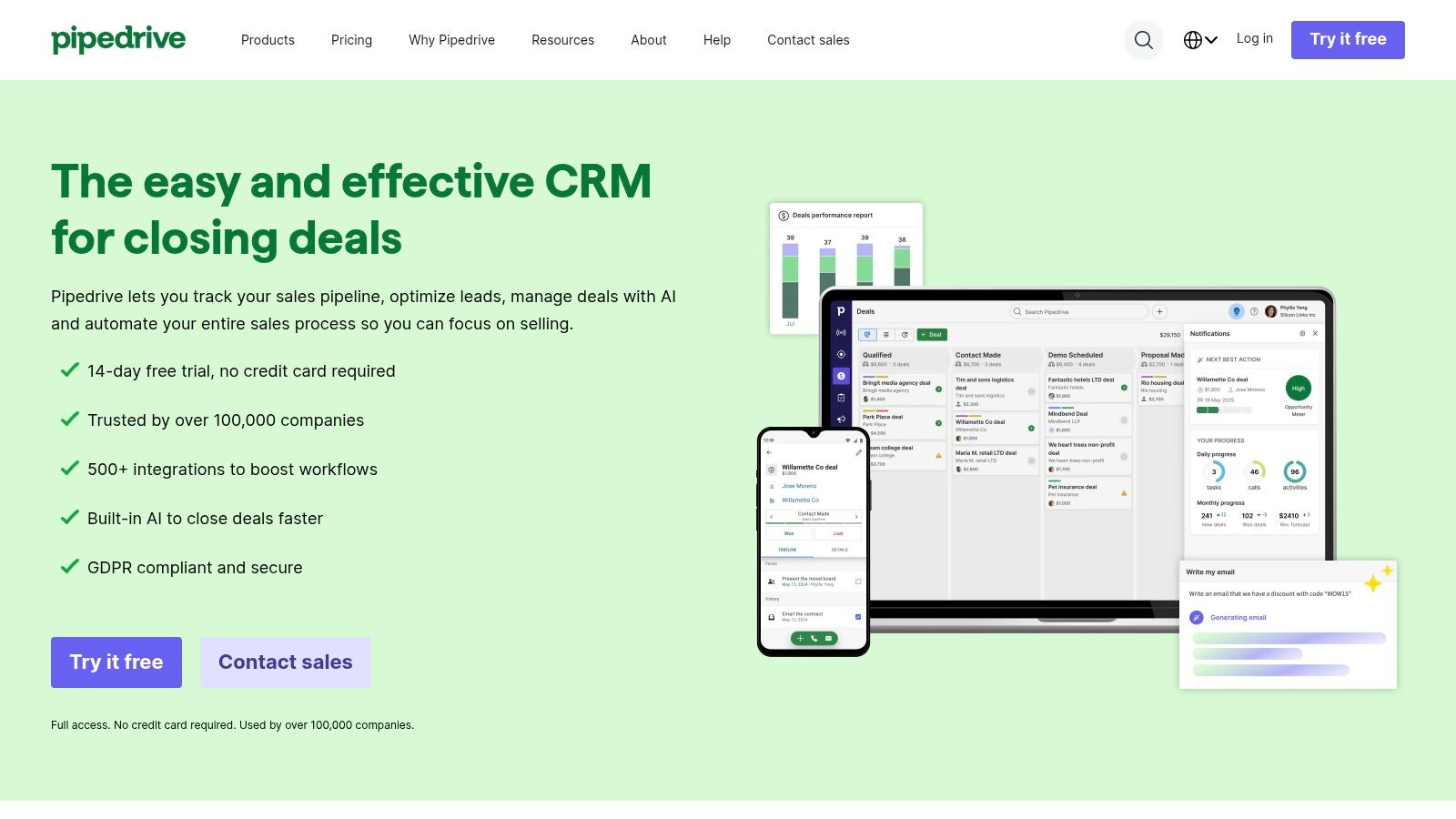
What makes Pipedrive unique is how it organizes both inbound and outbound efforts. Alongside LeadBooster for website visitors, the Prospector tool provides a credit-based database for sourcing outbound leads, allowing sales teams to build targeted lists without leaving the CRM. This integration means you can manage a lead from initial discovery on a prospect list to a qualified deal in the pipeline, all within one intuitive interface designed to minimize administrative work and maximize selling time. This is a practical approach for teams who need to both capture incoming interest and actively hunt for new business.
Key Strengths & Considerations
The platform’s simplicity is its greatest asset; teams can get up and running quickly with minimal training, which is a major advantage for smaller organizations without dedicated RevOps support. The LeadBooster add-on provides essential capture tools without needing third-party integrations. However, costs can creep up. Both LeadBooster and Prospector credits are additional expenses on top of the base CRM subscription, which can make it less cost-effective at scale. While excellent for sales execution, its native marketing automation and enterprise-level analytics are less robust compared to all-in-one suites like HubSpot.
- Website: https://www.pipedrive.com
5. Zoho CRM
Zoho CRM presents itself as a powerful and highly scalable lead generation management software, particularly for businesses seeking deep functionality without the enterprise-level price tag of some competitors. It is built around a comprehensive ecosystem of interconnected business apps, allowing you to manage everything from lead capture and scoring to sales pipelines and post-sale support within a single, integrated environment. This prevents data fragmentation and gives teams a unified view of the customer journey.
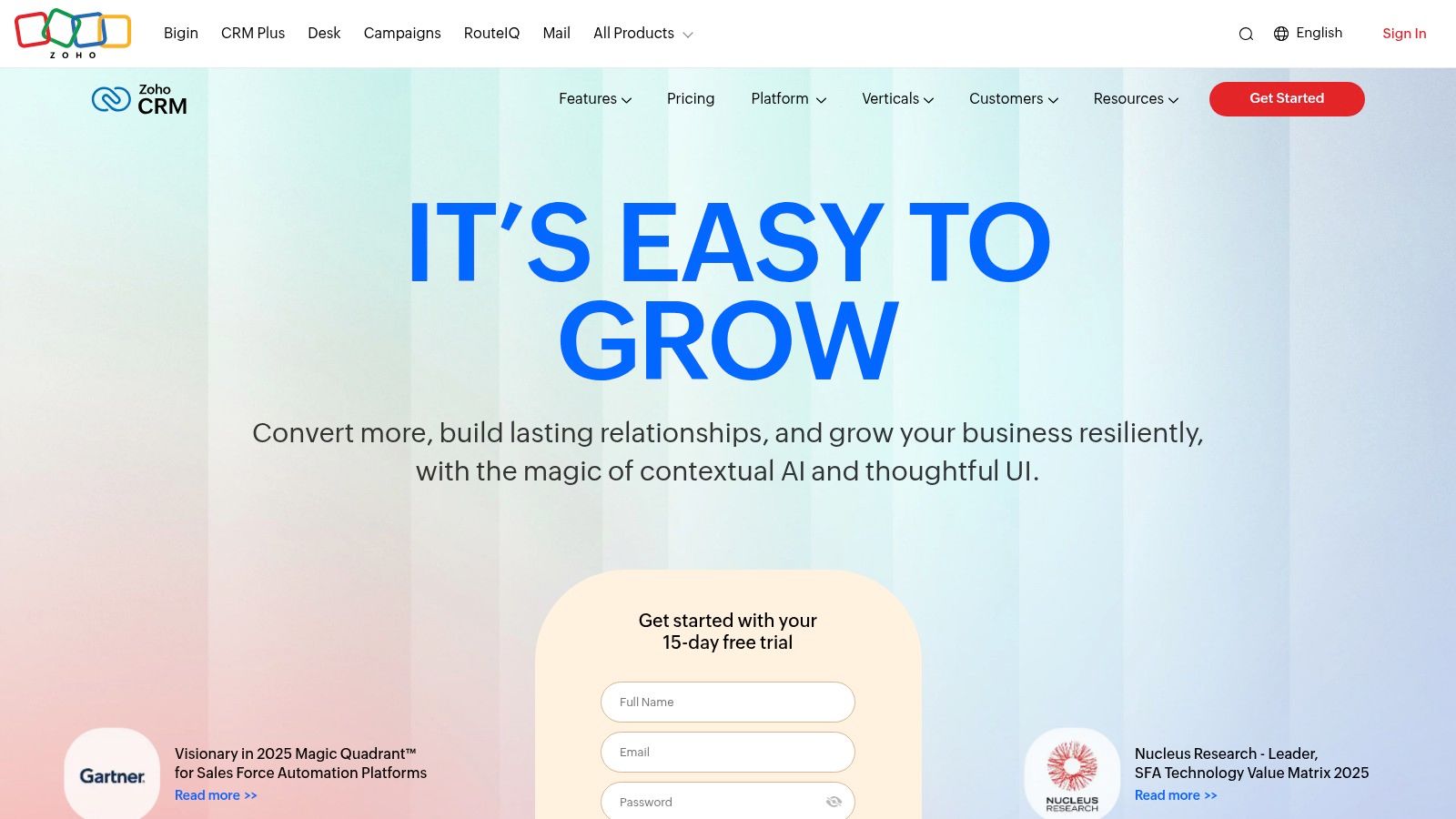
The platform’s strength lies in its customization and automation capabilities. You can design multi-stage lead nurturing workflows, automate lead assignment based on territory or product interest, and build custom dashboards to track critical lead generation KPIs. For instance, a lead generated from a specific ad campaign can be automatically routed to a dedicated pipeline and receive a tailored sequence of follow-up emails, ensuring timely and relevant engagement without manual intervention.
Key Strengths & Considerations
Zoho's aggressive pricing model delivers exceptional value, making robust CRM and automation features accessible to SMBs and mid-market companies that might find other platforms too costly. The extensive suite of integrated Zoho apps (like Zoho Analytics or Bigin for simpler CRM needs) offers a seamless path to expand functionality as your business grows. However, the sheer breadth of features and customization options can be overwhelming for new users, and unlocking the full potential of its enterprise capabilities may require dedicated setup expertise or a third-party consultant.
- Website: https://www.zoho.com/crm
6. Brevo (formerly Sendinblue)
Brevo, formerly known as Sendinblue, has carved out a significant niche as a powerful yet accessible lead generation management software, particularly for businesses seeking a multi-channel approach without an enterprise-level budget. It centralizes communication by integrating email, SMS, WhatsApp, and live chat into a single platform. This allows marketing and sales teams to capture and nurture leads across various touchpoints from one unified dashboard, avoiding the complexity of managing separate tools for each channel.
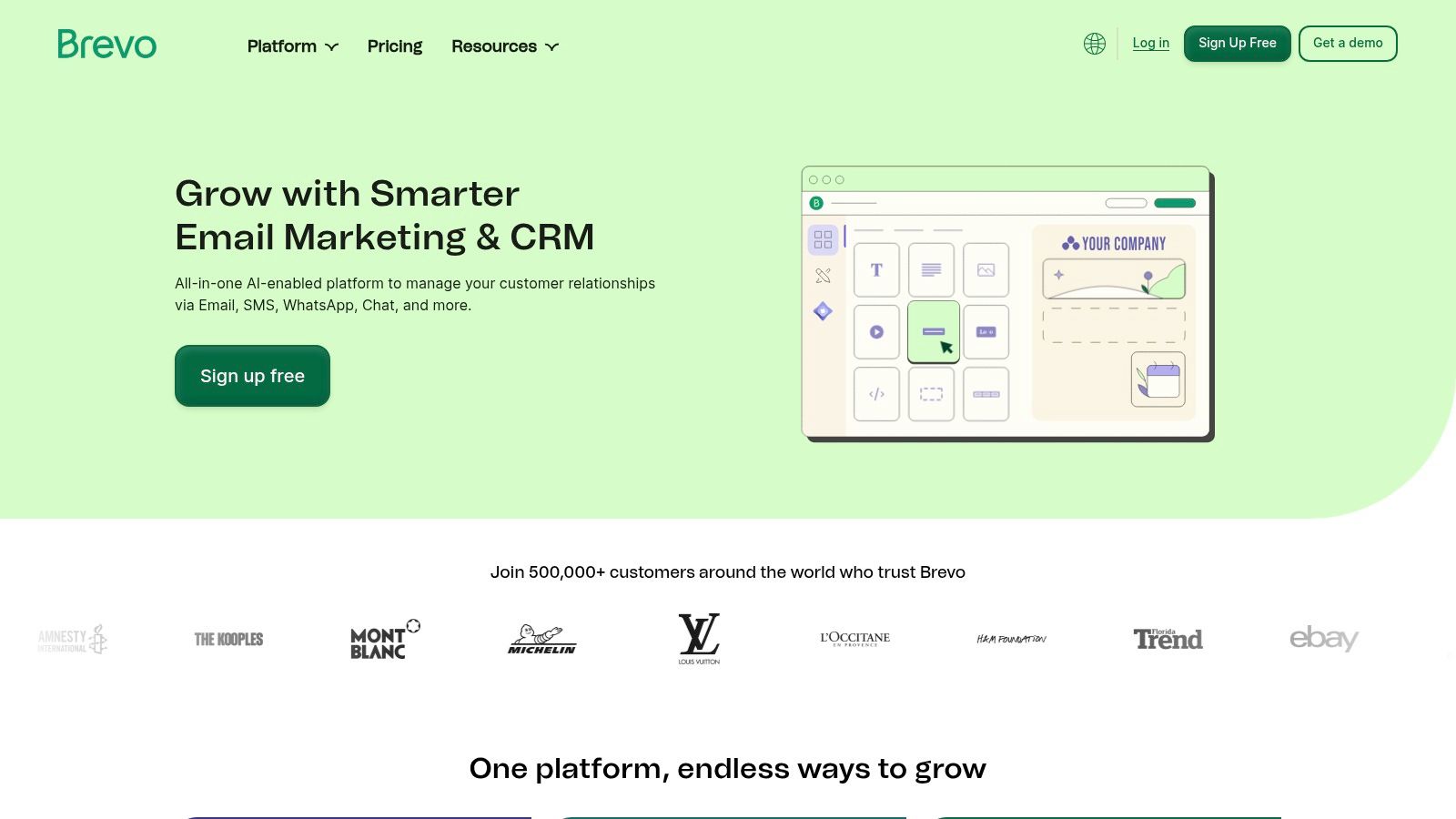
The platform's strength lies in making marketing automation straightforward. You can easily build workflows to welcome new subscribers from a landing page form, score them based on email engagement, and segment them for targeted follow-ups. For example, a new lead signing up for a webinar can be automatically added to a reminder sequence via email and SMS, ensuring higher attendance rates and a more organized lead management process from the very first interaction.
Key Strengths & Considerations
Brevo offers a generous free plan, making it an excellent starting point for businesses to build their lead generation engine without initial investment. The platform's transparent, volume-based pricing scales predictably as your contact list grows. Its European roots also make it a popular choice for businesses prioritizing EU data compliance. However, some of its more advanced sales-focused features, like VoIP calls and sophisticated CRM pipelines, are part of separate paid add-ons, which can increase the overall cost. The core marketing automation is robust, but teams requiring deep, native integrations with a wide array of specialized sales tools might find its capabilities more limited than some competitors.
- Website: https://www.brevo.com
7. ActiveCampaign
ActiveCampaign positions itself as an automation-first platform, making it a powerful choice for businesses that want to implement sophisticated, multi-step nurture campaigns without the enterprise-level price tag. It combines email marketing, marketing automation, and a sales CRM into one cohesive system, focusing on creating personalized customer experiences. This platform is particularly well-suited for small to medium-sized businesses (SMBs) looking for advanced automation capabilities that can scale with them.
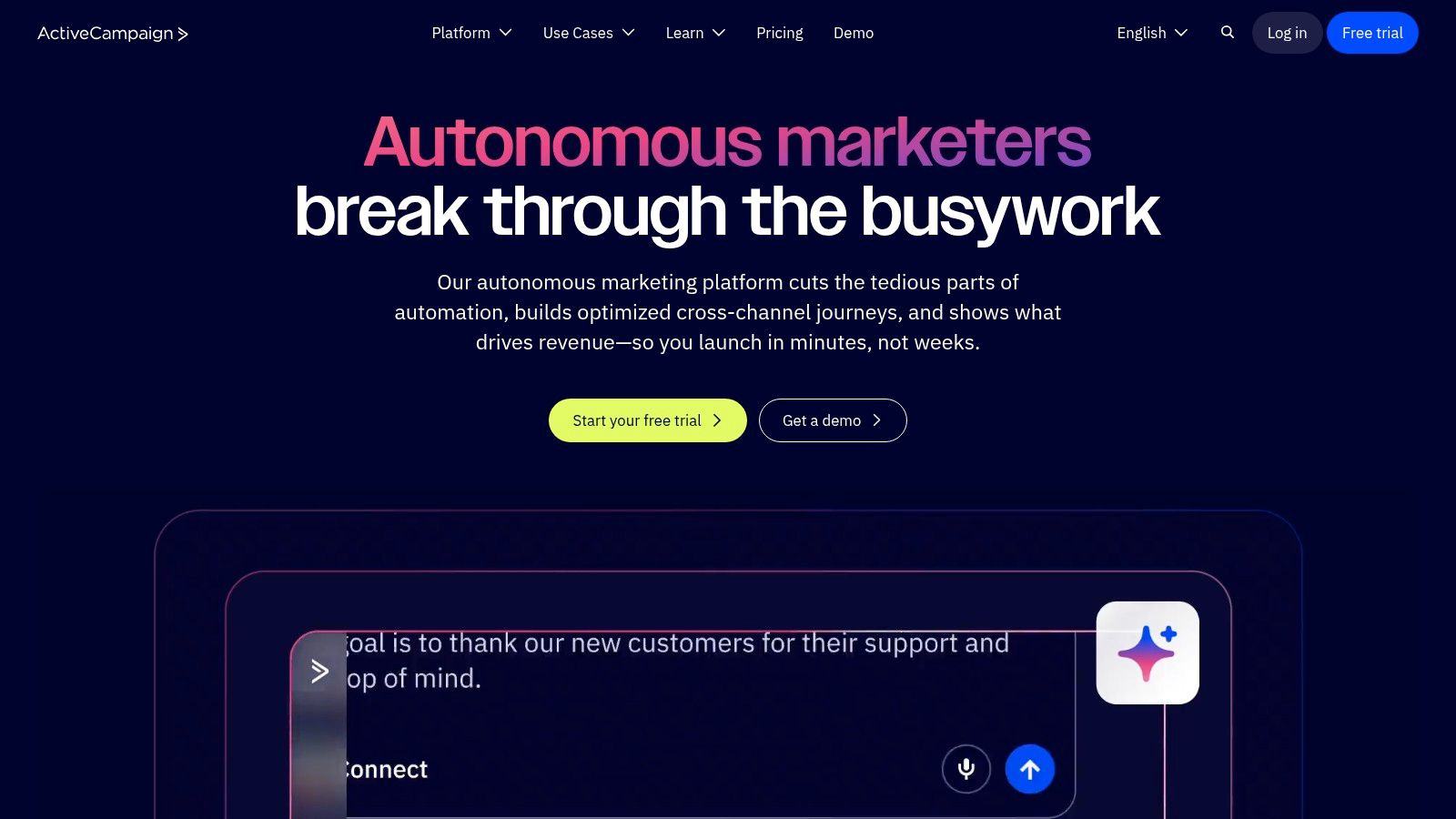
The core strength of ActiveCampaign lies in its visual automation builder. You can easily map out complex workflows using if/then logic, such as scoring leads based on site visits, email opens, and form submissions, then automatically moving them to different stages of the sales pipeline. For example, a contact who downloads a guide can be entered into an educational email series, while another who requests a demo is instantly assigned to a sales representative with a follow-up task created in the CRM.
Key Strengths & Considerations
The platform's automation features are impressively robust for its price point, offering capabilities often found in more expensive lead generation management software. Its wide adoption and extensive library of native integrations make it easy to connect with other essential tools in your marketing stack. ActiveCampaign also offers a 14-day free trial and provides migration support, lowering the barrier to entry for teams switching from other providers. However, the pricing model is tied directly to the number of contacts and the feature tier, so costs can increase significantly as your list grows. Additionally, the most detailed reporting and analytics are reserved for the higher-priced plans. To understand how it fits into a broader strategy, you can find more on the synergy between marketing automation and CRM systems.
- Website: https://www.activecampaign.com
100% Free Lead Magnet Audit
Our AI analyzes your website and delivers custom growth strategies in seconds.
8. Apollo.io
Apollo.io takes a different approach to lead generation management software by merging a massive B2B prospecting database directly with sales engagement tools. It’s designed for teams whose primary focus is outbound prospecting, allowing them to find, contact, and nurture leads all within a single, streamlined platform. This eliminates the need to subscribe to separate data providers and outreach sequencing tools, consolidating a critical part of the sales tech stack.
The platform’s strength lies in its ability to build highly targeted contact lists from its database of millions of companies and contacts, and then immediately enroll those prospects into automated email and call sequences. You can A/B test different messages, track engagement, and enrich contact data before syncing it to your main CRM. For instance, a sales team can build a list of VPs of Marketing in the SaaS industry, launch a multi-step outreach campaign, and automatically push any engaged leads directly into Salesforce or HubSpot.
Key Strengths & Considerations
The major advantage is combining data, enrichment, and engagement in one place, which drastically simplifies the outbound sales process. The free plan provides a generous entry point for users to test the core features before committing. However, its focus on outbound prospecting means it lacks the deep CRM functionality and inbound marketing features of all-in-one platforms. High-volume usage will require purchasing additional credits, which can increase costs for aggressive sales teams. It's an excellent tool for building the top of the funnel, but not a complete replacement for a dedicated CRM. For more details, you can understand more about a lead generation system.
- Website: https://www.apollo.io
9. G2 (Lead Management Software category)
While not a software platform itself, G2’s dedicated category for lead management is an indispensable resource for discovering and vetting potential solutions. It functions as a comprehensive B2B marketplace where businesses can explore an extensive list of lead generation management software options, side-by-side. Instead of relying solely on vendor marketing, G2 provides a layer of social proof through verified user reviews, detailed ratings, and candid feedback.
The platform excels at helping you build a data-driven shortlist. You can filter vendors by company size, industry, specific features, and user satisfaction scores, which significantly streamlines the research process. Its comparison grids allow you to place multiple tools head-to-head, visualizing key differences in functionality and user sentiment. This makes it easier to identify which platforms genuinely align with your team's specific requirements before you even book a demo.
Key Strengths & Considerations
The sheer breadth of its market coverage and the constant influx of fresh, up-to-date user reviews provide a powerful, unbiased starting point for your search. The ability to move directly from comparison to a vendor's site for a trial is incredibly efficient. However, it's crucial to be aware that sponsored placements can influence which vendors appear most prominently. Furthermore, pricing information is often not listed directly on G2, requiring you to visit individual vendor sites to get accurate cost details, which can add an extra step to your evaluation.
10. Capterra (Lead Management Software)
Capterra's global directory serves as an indispensable resource for businesses around the world. It operates as a comprehensive marketplace, offering curated lists and user reviews of lead generation management software tailored to a global audience. This is crucial for navigating international features, multi-language support, and integrations with business tools used worldwide, which some regionally-focused platforms might not cover.
The real value of the platform lies in its breadth and filtering capabilities. Instead of being limited to a specific region, international teams can find authentic feedback from peers across different markets. The interface allows for direct comparisons and provides links to provider websites, streamlining the process of requesting demos or starting trials with vendors equipped to handle global business requirements, from multi-currency invoicing to GDPR and CCPA compliance.
Key Strengths & Considerations
The primary advantage is the global context, which saves immense research time for international buyers. The related category suggestions (like CRM or lead capture tools) also help users build a complete marketing stack from globally relevant providers. However, users should be aware that sponsored listings are often prioritized in search results, so it's important to look beyond the top few options. Additionally, the listed pricing is often a starting point, and final costs should always be confirmed directly with the software vendor to avoid surprises.
11. OMR Reviews (Lead Management/CRM selections)
For businesses operating within or targeting the DACH market (Germany, Austria, Switzerland), OMR Reviews serves as an indispensable starting point rather than a direct software solution itself. It's a curated review portal that provides editorial context and user-generated feedback specifically for lead generation management software relevant to this region. Instead of a global-first approach, OMR focuses on the tools, integrations, and compliance needs (like GDPR) that are top-of-mind for European organizations.

The platform helps marketing and sales leaders bypass the noise of sprawling international review sites by shortlisting platforms that have a proven track record in the German-speaking market. This includes not just global giants but also strong local contenders and "Mittelstand-friendly" solutions that might otherwise be overlooked. It allows teams to quickly compare top-rated options, read authentic user reviews, and access editorial guides that frame the selection process within a regional business context, streamlining the initial research phase significantly.
Key Strengths & Considerations
The primary strength of OMR Reviews is its laser focus on the DACH market, ensuring the featured tools are well-suited for local business practices and data protection standards. This specialized curation is excellent for creating a high-quality shortlist of potential vendors without sifting through hundreds of irrelevant global options. However, this regional specialization is also its main limitation; the total number of vendors reviewed is considerably smaller than on platforms like G2 or Capterra. Furthermore, some of the content is more editorial and high-level, which is great for strategy but may lack the deep technical dive that some RevOps teams require for a final decision.
- Website: https://omr.com/reviews
12. AWS Marketplace (CRM / Lead solutions)
While not a singular software solution, AWS Marketplace serves as a crucial procurement channel for organizations deeply embedded in the Amazon Web Services ecosystem. It acts as a digital catalogue where businesses can find, test, buy, and deploy third-party lead generation management software, CRM platforms, and data enrichment tools that run on AWS. This approach is particularly beneficial for enterprises with stringent IT governance and vendor onboarding processes, as it centralizes billing and simplifies compliance.

The primary advantage lies in its integration with existing enterprise procurement workflows. Teams can leverage their AWS accounts and budgets to acquire tools from well-known vendors and niche providers alike, often through private offers or pre-negotiated contracts. Instead of a lengthy new-vendor process, a marketing team can request access to a lead scoring API or a specialized CRM, and the IT or finance department can approve and manage it through a familiar, trusted interface, streamlining the entire acquisition lifecycle.
Key Strengths & Considerations
The ability to consolidate software spending onto a single AWS bill is a major draw for finance and operations teams, making it a powerful channel for vendor management. It simplifies the often-complex process of onboarding and vetting new software, which can be a significant bottleneck in large companies. However, this platform is not a typical software discovery site. Many listings require you to request a private quote rather than showing transparent pricing, and its true value is only realized by organizations already using AWS for procurement. For those not tied to the AWS ecosystem, direct engagement with software vendors is usually more straightforward.
- Website: https://aws.amazon.com/marketplace
Top 12 Lead-Gen Management Tools Comparison
| Tool | Core features ✨ | UX / Quality ★ | Value / Price 💰 | Target audience 👥 | Unique selling point 🏆 |
|---|---|---|---|---|---|
| HubSpot (Marketing Hub + CRM) | Forms, chat, automation, native CRM, attribution | ★★★★ — Mature dashboards & workflows | 💰 Free tier → paid tiers scale by contacts/seats | 👥 SMBs → mid‑market marketers & agencies | 🏆 End‑to‑end platform + large ecosystem |
| Salesforce Sales Cloud | Lead capture/routing, engagement, AppExchange | ★★★★ — Enterprise‑grade, configurable (complex) | 💰 High TCO; add‑ons often required | 👥 Large enterprises & complex sales orgs | 🏆 Highly configurable with vast partner network |
| Microsoft Dynamics 365 Sales | Lead/opportunity mgmt, AI Copilot, Teams/Outlook | ★★★★ — Familiar MS UX, strong security | 💰 Transparent pricing; best in MS stack | 👥 Enterprises using Microsoft 365/LinkedIn | 🏆 Copilot + deep LinkedIn/Office integrations |
| Pipedrive (CRM + LeadBooster) | Visual pipeline, LeadBooster (chat/forms), Prospector | ★★★★ — Simple, fast adoption | 💰 SMB‑friendly; Prospector credits extra | 👥 SMB sales teams & startups | 🏆 Quick implementation + focused sales UX |
| Zoho CRM | Lead capture/scoring, workflows, multi‑app suite | ★★★½ — Feature‑rich, some complexity | 💰 Aggressive pricing; strong feature value | 👥 Budget‑conscious SMBs → enterprises | 🏆 Broad app ecosystem at low cost |
| Brevo (formerly Sendinblue) | Email/SMS/WhatsApp, automation, forms, lightweight CRM | ★★★★ — Easy multi‑channel UX; strong compliance | 💰 Clear tiers + free plan; EU-friendly | 👥 Global SMEs & marketers | 🏆 EU-based multi-channel platform |
| ActiveCampaign | Visual automations, scoring, forms, CRM | ★★★★ — Automation‑first, SMB friendly | 💰 Competitive SMB pricing; scales with contacts | 👥 SMB marketers who value automation | 🏆 Powerful automations + migration support |
| Apollo.io | B2B contact database, sequences, enrichment | ★★★½ — Strong outbound tooling, light CRM | 💰 Free tier; credits for enrichment/outreach | 👥 Outbound SDRs & sales ops teams | 🏆 Data + engagement in one product |
| G2 (Lead Management category) | Category pages, verified reviews, comparison grids | ★★★★ — Trusted review ecosystem | 💰 Free to use; vendor sponsored placements | 👥 Buyers shortlisting lead‑management tools | 🏆 Large verified‑review marketplace |
| Capterra | Global listings, buyer guides, demos | ★★★½ — Global UX & filters | 💰 Free; vendor lead generation via links | 👥 Global buyers researching vendors | 🏆 Global marketplace with broad selection |
| OMR Reviews | Curated DACH lists, editorial rundowns, user feedback | ★★★½ — Editorial DACH context | 💰 Free; curated editorial insights | 👥 DACH marketers seeking curated shortlists | 🏆 Strong DACH editorial focus |
| AWS Marketplace (CRM / Lead solutions) | SaaS/API listings, private offers, centralized billing | ★★★★ — Enterprise procurement UX | 💰 Enterprise pricing; private quotes common | 👥 IT/governance‑heavy enterprises | 🏆 Procurement + compliance + consolidated billing |
From Chaos to Clarity: Choosing Your Path Forward
Navigating the crowded market for lead generation management software can feel overwhelming. We've analyzed everything from all-in-one giants like HubSpot and Salesforce to more focused platforms like Apollo.io and ActiveCampaign. The core truth remains: the perfect tool is not a universal solution but a personalized fit for your organization's unique challenges and scale.
Let's be blunt: no single piece of software will magically solve all your lead generation problems. The tool is only as good as the strategy behind it. However, the right system brings order to chaos, automates tedious work, and provides the data needed to make smart decisions. It transforms a messy spreadsheet and a collection of disconnected apps into a streamlined, predictable revenue engine.
Key Takeaways and Your Next Steps
Before you pull out the company credit card, pause and reflect on the insights from this guide. Your final decision should not be based on a feature list alone, but on a deep understanding of your team's workflow, technical capabilities, and future growth ambitions.
Here’s a practical framework to guide your decision-making process:
- Audit Your Current Process First: What are the most significant friction points in your current lead management system? Are you struggling with lead scoring, slow follow-up times, poor data hygiene, or a lack of visibility into your funnel? Identify the core problem you need the software to solve.
- Match the Tool to Your Team's Scale: A solo entrepreneur or a small team does not need the enterprise-level complexity of Salesforce or Microsoft Dynamics 35. A tool like Pipedrive or Brevo offers powerful functionality without the steep learning curve and implementation cost. Conversely, a large sales organization will quickly outgrow simpler systems and needs the robust customization and reporting of an enterprise-grade platform.
- Prioritize Integration Capabilities: Your lead generation management software must act as your central hub. Does it integrate seamlessly with your email marketing platform, your advertising channels, your customer support desk, and your data analytics tools? A tool that creates data silos is a liability, not an asset. Check for native integrations or robust API access.
- Run a Pilot Program: Never commit to a platform-wide rollout without a trial. Select a small, agile team to test your top two choices in a real-world scenario for at least 30 days. Let them document the pros and cons of daily use. This practical feedback is infinitely more valuable than any sales demo.
The Engine and the Fuel: A Final Thought
The platforms we've discussed are the powerful engines. But an engine is useless without high-quality fuel. Here's a controversial take: most lead magnets are boring and ineffective. The real magic happens when you pair a powerful management system with a lead generation method that truly engages your audience.
Forget static PDFs and generic checklists. The future is interactive. Think calculators, quizzes, and self-assessments that provide instant, personalized value. These are not just lead magnets; they are conversation starters that qualify prospects while they engage. They pull in the right people by helping them solve a real problem, right on your website. This approach fundamentally shifts the dynamic from chasing leads to attracting qualified buyers.
Before you invest in a new system, understanding the strength of your current lead generation approach is key. To get a clear picture, you can use a free tool like our lead magnet audit at Magnethive (https://magnethive.io?ref=post). It generates a comprehensive report with 3 AI-powered lead magnet ideas, analysis of your current lead magnet (if you have one), and shows ROI impact. It is 100% free to use.
Once you have a high-quality stream of leads, the software we've discussed today will be the system that turns them into revenue. Pick the one that fits your team's workflow and scale, and you'll finally have the predictable growth machine you have been trying to build. You have the map; now it's time to choose your path and start the journey.